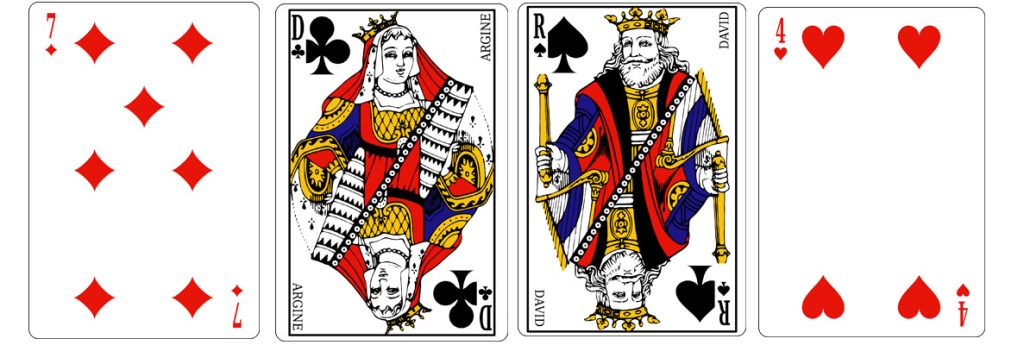In the United States, the culture of “Thinking outside the box” has become inescapable. Coaches and managers all propose to solve problems by thinking differently, “outside the box.” The expression comes from the nine dots puzzle, in which the problem to be solved is how to join up nine dots using four straight lines, without lifting the pen from the paper, and without tracing the same line more than once. This puzzle can drive you mad if you try and stay within the frame or “box”, because, in order to solve it, the lines must be drawn… outside of the square. Personally, I also like illustrating this way of thinking with a puzzle that I found in an Italian book, and that, ever since, I have therefore called the “Italian cards” puzzle. Will you be able to find the solution?
In this exercise, the underlying principle is that each face has a number on the other side its card. The rule to check is the following: “Every Queen has a 4 on the other side of her card”.
Which 2 cards should you turn over?

.
.
.
.
.
.
.
.
Have you worked it out!
.
.
.
.
Of course, you need to start by turning the Queen over, to check that she does indeed have a 4 on the other side. But if you went a little too fast, like most people do, without thinking things through, you were doubtless tempted to turn over the Four of Hearts to check if it does indeed have a Queen on the other side. And that is a big mistake! Because if it doesn’t, that will not tell you anything useful, because nothing in the wording of the problem says that a Jack or a King cannot also have a 4 on its other side. The King won’t tell us anything either, and so it is indeed the 7 that should be turned over, because if it has a Queen on the other side, the rule is false…
Why does everyone make the same mistake? Because we are all tempted to go for simplicity. When we drop our keys in the street, we all start looking for them under a lit streetlamp…
By being aware of this weakness, we can start to overcome it by systematically asking ourselves whether our strategies are not motivated by a desire for simplicity.
For example, instead of organising a prospecting campaign within the immediate vicinity of your office because it seems easier to travel within that area, why not take the time to prepare a campaign that is more qualified based on chosen and cross-compared criteria? We might also think back to this card game while seeking to identify the cause of a problem: is the first explanation that is immediately obvious the one we should analyse, or should we not check that it does not itself result from another situation further upstream? I will be able to return to this some other time when talking about Ishikawa (the Japanese thinker behind “Total Quality”), but in the meantime don’t forget to take the time to step to one side and look at the problem from another angle before you act!
NEWSLETTER
Pour être informé de nos événements, de nos webinaires et de notre actualités, abonnez-vous à notre newsletter :
© Copyright 2024 - RETORIKA